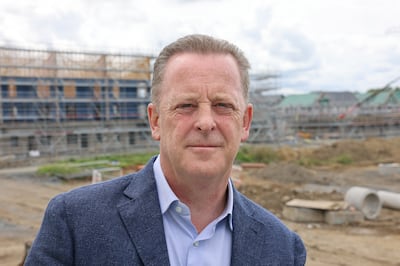The listings in today’s new-homes special supplement might give one the impression that the supply of housing is plentiful. The reality on the ground, however, is that the housing crisis continues to rumble on. The seeds of this ongoing malaise were sowed nearly two decades ago now in the reckless, credit-fuelled years towards the tail end of the Celtic Tiger. They were then allowed to take root and to develop by successive governments who swung the pendulum in the opposite direction and became wedded to austerity at all costs. But while there can be no quick fix to the housing crisis now, there are measures that can help to address the yawning imbalance between supply and demand. Here, three of the most prominent figures from the construction industry give their views on the current state of play in the residential property market and on what needs to be done to accelerate the delivery of new homes further.
Michael O’Flynn, O’Flynn Group chairman and chief executive
We came into this decade with a major housing deficit. As each year passes and we fail to meet current demand, that deficit increases. There are two key reasons for this.
Firstly, there is a lack of availability of zoned and serviced land. The 2022 census figures demonstrate that the National Planning Framework (NPF) figures are outdated and significantly underestimated housing demand. Those figures have informed the housing need and demand assessments which, in turn, have given rise to the de-zoning of land which could have delivered a very significant number of units throughout the country. Any serious attempt to address our housing deficit must include zoning and servicing sufficient land which is available for development.
‘I am divorced at 60, envious of my ex-husband’s new life and struggling with loneliness’
Look inside the most expensive house sold in Dublin so far this year
‘I learned about Irish time. People arrive late and think they are on time’
Bishop Casey’s Buried Secrets review: ‘He had no fear of being caught’
Secondly, viability remains a major challenge. The suggestion by some that the Government initiatives are fuelling house price inflation is incorrect as there are no such initiatives for second-hand housing and yet we have seen similar house price inflation in this market. The lack of new housing supply for both sale and rental is the issue here. The reality is that housing delivery is complex, involves risk and that viability remains a major challenge. Scarcity of zoned land puts pressure on land prices and exacerbates the viability issue.

The Government initiatives have helped to address viability. Among them are the help-to-buy and First Home schemes, the development levy waiver, Croí Cónaithe and Project Tosaigh. These initiatives go some way towards counterbalancing the substantial cost increases in both material and labour over the last few years.
In some locations, however, particularly in brownfield areas which are a key part of the NPF and accounts for 50 per cent of the zonings in the key settlement areas, it is still not viable to deliver these schemes which is negatively impacting new housing supply.
The Government initiatives make absolute economic sense and should be retained. Already we are losing international investment because of the lack of housing availability. A whole generation has been locked out of home ownership and, indeed, of even having a home to rent. By supporting housing delivery, the Government benefits from VAT, which adds 13.5 per cent to the price of every new home; from income taxes; property taxes; and from the obvious economic benefits of retaining international investment and the social benefits of relieving the shortage of housing.
Pat Farrell, Irish Institutional Property chief executive
Irish Institutional Property was founded in 2019. Its members are leading the funding and delivery of new homes of all tenure types in the Irish market. We estimate that by 2026 members will have delivered about 58,000 new homes. From that vantage point IIP is well placed to review the challenges and opportunities that lie ahead, particularly the need to significantly increase output of new homes well beyond current targets. The steady annual material increase of new homes under the Housing for All plan to a high of about 33,000 homes last year should now give the Government and policymakers the confidence to reset these targets.

Central to increased output is the range of financial and other supports made available by government to tackle viability and pave the way for increased delivery. For the market in general and institutional investors in particular to effectively respond there is a need for clear signalling from government that these supports will be maintained, that our planning system is resourced up and that a stable competitive policy regime will be maintained for institutional funding which, it is now generally recognised, will continue to be the only realistic and major source of finance for new homes complementing funding by government and the banking sector.
Michael Stanley, Cairn Homes chief executive
We are passionate about the homes we build and after closing 1,741 homes last year, more than 20,000 people now live in the 7,500+ Cairn homes we have built to date. We look forward to doubling this number over the next few years.

More broadly, year-on-year housing supply is growing. Yet, despite essential Government supports, a mere 10 per cent of annual housing transactions are newly-built homes purchased by first-time buyers. To put this in context, just over 5,000 young families received keys to new homes in Ireland in 2023. Encouragingly, awareness and take-up of the Government’s First Home shared-equity scheme is improving. However, a significant increase in the supply of new homes is needed and at sales prices below the caps set by the Government for this crucial support.
Given the insufficient number of affordable homes for first-time buyers to purchase, the Government has also prioritised the completion of well-located, affordable rental apartment developments. These scaled new developments, which in the main will be State-owned assets, could well offer truly affordable, long-term or transitional housing solutions for tens of thousands of young people working in our economy.





